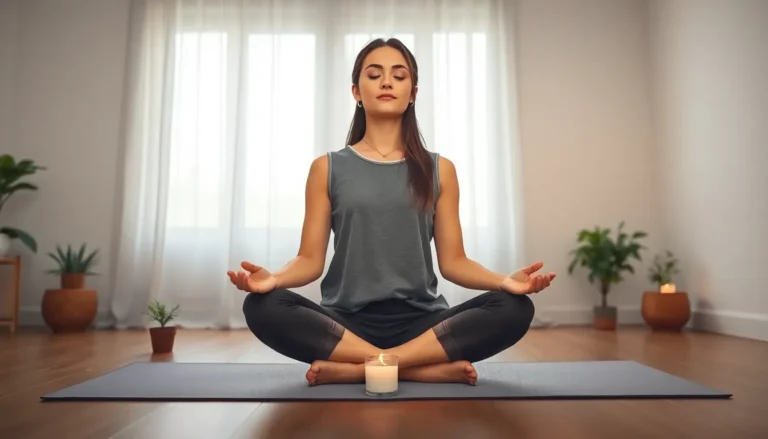Table of Contents
ToggleIn a world buzzing with deadlines and distractions, finding a moment of peace can feel like searching for a unicorn in a haystack. But what if mindfulness could be fun? That’s right! It’s time to trade in the serious meditation sessions for some lighthearted activities that not only calm the mind but also bring a smile to the face.
Imagine practicing mindfulness while coloring outside the lines or laughing your way through a yoga class that feels more like a comedy show. These fun mindfulness activities for adults aren’t just about zen; they’re about enjoying the journey and embracing the quirks of life. So grab your favorite beverage, kick back, and discover how mindfulness can be a delightful adventure rather than a chore.
Understanding Mindfulness
Mindfulness represents a focused state of awareness, centering attention on the present moment. It’s about observing thoughts and feelings without judgment. This practice encourages individuals to notice their surroundings, sensory experiences, and inner dialogue.
Practicing mindfulness cultivates an appreciation for simplicity. It allows people to find pleasure in everyday routines. Engaging in mindfulness reduces stress levels significantly while enhancing overall well-being. Research indicates mindfulness activities can lead to improved mental clarity and emotional resilience.
Mindfulness engages various techniques, including meditation and breathing exercises. These approaches help people focus on their breath or bodily sensations, fostering a deeper connection to oneself. Tuning into one’s thoughts opens pathways for enhanced self-awareness and reflection.
Incorporating mindfulness into daily life proves beneficial. Simple activities like mindful walking or eating encourage individuals to savor experiences fully. These exercises help shift attention away from distractions, creating space for tranquility and joy.
Furthermore, adopting a playful attitude regarding mindfulness enhances its accessibility. Approaching mindfulness with fun elements can spark interest and motivate participation. Playful activities, such as nature journaling or mindful cooking, invite creativity while promoting relaxation.
Ultimately, mindfulness invites individuals to enjoy the moment, contributing to a balanced lifestyle. By integrating these practices into daily routines, people can cultivate calmness amid chaos. They can embrace mindfulness as an enjoyable journey, enriching their lives while discovering peace and joy in the here and now.
Benefits of Mindfulness Activities
Engaging in mindfulness activities delivers numerous benefits, especially for adults aiming for balance and peace. These activities enhance mental clarity and emotional resilience.
Mental Health Enhancements
Mindfulness practices substantially boost mental health. They reduce anxiety symptoms, with studies indicating a 58% decrease in anxiety levels among routine practitioners. Practitioners of mindfulness report improved mood, thanks to the focus on the present. Enhanced self-awareness and reduced rumination often result from consistent engagement in mindfulness activities. Individuals find themselves better equipped to handle stress and emotional challenges, promoting emotional stability and resilience. Accessing techniques like meditation fosters a deeper connection with thoughts and feelings, enabling proactive emotional management.
Physical Well-Being
Physical health benefits significantly from mindfulness activities. Regular participants experience a reduction in stress-related symptoms, leading to lower blood pressure and enhanced immune function. Activities promote relaxation, which contributes to overall physical health. Engaging in mindful walking or yoga increases physical activity levels and improves flexibility. Practicing mindfulness in daily activities encourages healthier eating habits and mindful consumption. Studies have shown that individuals who practice mindfulness frequently report greater energy levels and improved sleep quality. Prioritizing physical well-being through mindfulness also fosters enjoyment in movement and activity.
Fun Mindfulness Activities for Adults
Engaging in mindfulness can be fun and uplifting. Here are several enjoyable activities that adults can explore.
Creative Mindfulness Practices
Art offers a fantastic outlet for mindfulness. Drawing or painting can allow thoughts to flow freely without judgment. Engaging in coloring books provides a chance for adults to unleash creativity while focusing on each stroke. Crafting projects, such as making vision boards, boosts mindfulness through intentionality. Journaling fosters self-reflection, inviting deeper insights into emotions. Additionally, practicing photography encourages users to notice details in their environment, enhancing awareness.
Outdoor Activities
Nature presents an ideal setting for mindfulness. Walking through parks cultivates a connection with surroundings, allowing individuals to focus on sensations and sounds. Hiking up trails heightens awareness of natural beauty while promoting physical exercise. Gardening can ground and center people, with every planting or nurturing moment drawing attention to the present. Additionally, outdoor meditation encourages one to breathe in fresh air, enriching the experience of tranquility. Picnicking outdoors creates space for mindful eating, emphasizing the flavors and textures of food.
Group Mindfulness Exercises
Group activities can amplify mindfulness experiences. Practicing yoga in a group setting fosters community and shared energy. Guided meditation sessions allow participants to explore various techniques while benefiting from collective focus. Mindful movement classes give people the opportunity to connect and engage their bodies together. Team-building exercises that incorporate mindfulness help cultivate trust and communication among members. Participating in workshops focused on mindfulness practices further enriches personal growth while building community.
Incorporating Mindfulness into Daily Life
Incorporating mindfulness into daily life enhances experiences and reduces stress. Simple adjustments yield significant benefits.
Simple Practices
Engaging in mindful walking encourages awareness of surroundings. Observing sights and sounds while walking promotes a connection to the present moment. Eating mindfully allows individuals to savor flavors and textures, making mealtimes more enjoyable. Deep breathing exercises provide quick stress relief anytime. Practicing gratitude by noting three things to appreciate each day can shift focus to positivity. Integrating these simple practices transforms ordinary moments into opportunities for mindfulness, improving overall well-being.
Setting Achievable Goals
Setting achievable goals fosters a sustainable mindfulness practice. Breaking larger objectives into smaller, manageable steps ensures progress remains consistent. Individuals can commit to one minute of mindfulness each day, gradually increasing the duration. Monthly challenges, such as trying a new mindfulness activity each week, keep engagement high. Tracking progress through journals or apps provides motivation and accountability. Celebrating small victories reinforces the practice, showing how mindful living can seamlessly integrate into daily routines.
Embracing fun mindfulness activities can transform the way adults experience their daily lives. By incorporating playful practices into routines, individuals can discover a refreshing approach to self-care and stress relief. These activities not only promote relaxation but also foster creativity and connection with oneself and others.
As adults navigate their busy lives, making time for enjoyable mindfulness practices can lead to lasting benefits. Whether it’s through art, nature, or community engagement, each moment spent in mindfulness enriches overall well-being. With a lighter perspective on mindfulness, individuals can cultivate a more balanced and joyful existence.




